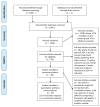Socioeconomic inequalities in lung cancer treatment: systematic review and meta-analysis
- PMID: 23393428
- PMCID: PMC3564770
- DOI: 10.1371/journal.pmed.1001376
Socioeconomic inequalities in lung cancer treatment: systematic review and meta-analysis
Abstract
Background: Intervention-generated inequalities are unintended variations in outcome that result from the organisation and delivery of health interventions. Socioeconomic inequalities in treatment may occur for some common cancers. Although the incidence and outcome of lung cancer varies with socioeconomic position (SEP), it is not known whether socioeconomic inequalities in treatment occur and how these might affect mortality. We conducted a systematic review and meta-analysis of existing research on socioeconomic inequalities in receipt of treatment for lung cancer.
Methods and findings: MEDLINE, EMBASE, and Scopus were searched up to September 2012 for cohort studies of participants with a primary diagnosis of lung cancer (ICD10 C33 or C34), where the outcome was receipt of treatment (rates or odds of receiving treatment) and where the outcome was reported by a measure of SEP. Forty-six papers met the inclusion criteria, and 23 of these papers were included in meta-analysis. Socioeconomic inequalities in receipt of lung cancer treatment were observed. Lower SEP was associated with a reduced likelihood of receiving any treatment (odds ratio [OR] = 0.79 [95% CI 0.73 to 0.86], p<0.001), surgery (OR = 0.68 [CI 0.63 to 0.75], p<0.001) and chemotherapy (OR = 0.82 [95% CI 0.72 to 0.93], p = 0.003), but not radiotherapy (OR = 0.99 [95% CI 0.86 to 1.14], p = 0.89), for lung cancer. The association remained when stage was taken into account for receipt of surgery, and was found in both universal and non-universal health care systems.
Conclusions: Patients with lung cancer living in more socioeconomically deprived circumstances are less likely to receive any type of treatment, surgery, and chemotherapy. These inequalities cannot be accounted for by socioeconomic differences in stage at presentation or by differences in health care system. Further investigation is required to determine the patient, tumour, clinician, and system factors that may contribute to socioeconomic inequalities in receipt of lung cancer treatment.
Conflict of interest statement
GR is a member of several advisory groups for the Department of Health's National Awareness and Early Diagnosis Initiative. All other authors have declared that no competing interests exist.
Figures





References
-
- Cancer Research UK Cancer incidence: UK statistics. Available: http://info.cancerresearchuk.org/cancerstats/incidence/. Accessed 09 January 2013.
-
- Howlader N, Noone AM, Krapcho M, Neyman N, Aminou R, et al. .. (eds). SEER Cancer Statistics Review, 1975–2009 (Vintage 2009 Populations), National Cancer Institute. Bethesda, MD. Based on November 2011 SEER data submission, posted to the SEER web site, April 2012. Available: http://seer.cancer.gov/csr/1975_2009_pops09/. Accessed 09 January 2012.
-
- Cancer Research UK Common cancers - UK mortality statistics. Available: http://info.cancerresearchuk.org/cancerstats/mortality/cancerdeaths/. Accessed 09 January 2013.
-
- Verdecchia A, Francisci S, Brenner H, Gatta G, Micheli A, et al. (2007) Recent cancer survival in Europe: a 2000–02 period analysis of EUROCARE-4 data. Lancet Oncol 8: 784–796. - PubMed
Publication types
MeSH terms
Grants and funding
LinkOut - more resources
Full Text Sources
Other Literature Sources
Medical
Miscellaneous

